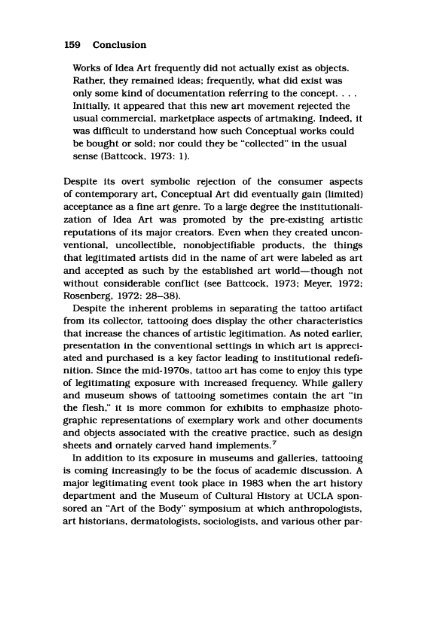Customizing the Body (PDF file) - Print My Tattoo
Customizing the Body (PDF file) - Print My Tattoo
Customizing the Body (PDF file) - Print My Tattoo
You also want an ePaper? Increase the reach of your titles
YUMPU automatically turns print PDFs into web optimized ePapers that Google loves.
159 Conclusion<br />
Works of Idea Art frequently did not actually exist as objects.<br />
Ra<strong>the</strong>r. <strong>the</strong>y remained ideas; frequently. what did exist was<br />
only some kind of documentation referring to <strong>the</strong> concept....<br />
Initially. it appeared that this new art movement rejected <strong>the</strong><br />
usual commercial. marketplace aspects of artmaking. Indeed. it<br />
was difficult to understand how such Conceptual works could<br />
be bought or sold; nor could <strong>the</strong>y be "collected" in <strong>the</strong> usual<br />
sense (Battcock. 1973: 1).<br />
Despite its overt symbolic rejection of <strong>the</strong> consumer aspects<br />
of contemporary art. Conceptual Art did eventually gain (limited)<br />
acceptance as a fine art genre. To a large degree <strong>the</strong> institutionalization<br />
of Idea Art was promoted by <strong>the</strong> pre-existing artistic<br />
reputations of its major creators. Even when <strong>the</strong>y created unconventional.<br />
uncollectible. nonobjectifiable products. <strong>the</strong> things<br />
that legitimated artists did in <strong>the</strong> name of art were labeled as art<br />
and accepted as such by <strong>the</strong> established art world-though not<br />
without conSiderable conflict (see Battcock. 1973; Meyer. 1972;<br />
Rosenberg. 1972: 28-38).<br />
Despite <strong>the</strong> inherent problems in separating <strong>the</strong> tattoo artifact<br />
from its collector. tattooing does display <strong>the</strong> o<strong>the</strong>r characteristics<br />
that increase <strong>the</strong> chances of artistic legitimation. As noted earlier.<br />
presentation in <strong>the</strong> conventional settings in which art is appreciated<br />
and purchased is a key factor leading to institutional redefinition.<br />
Since <strong>the</strong> mid-1970s. tattoo art has come to enjoy this type<br />
of legitimating exposure with increased frequency. While gallery<br />
and museum shows of tattooing sometimes contain <strong>the</strong> art "in<br />
<strong>the</strong> flesh." it is more common for exhibits to emphasize photographic<br />
representations of exemplary work and o<strong>the</strong>r documents<br />
and objects associated with <strong>the</strong> creative practice. such as design<br />
sheets and ornately carved hand implements. 7<br />
In addition to its exposure in museums and galleries. tattooing<br />
is coming increasingly to be <strong>the</strong> focus of academic discussion. A<br />
major legitimating event took place in 1983 when <strong>the</strong> art history<br />
department and <strong>the</strong> Museum of Cultural History at UCLA sponsored<br />
an "Art of <strong>the</strong> <strong>Body</strong>" symposium at which anthropologists.<br />
art historians. dermatologists. sociologists. and various o<strong>the</strong>r par-



